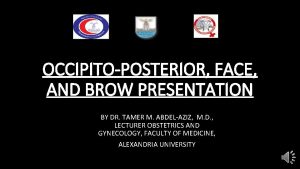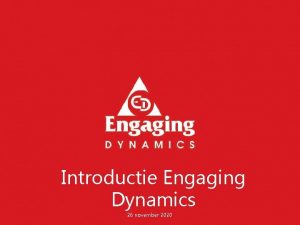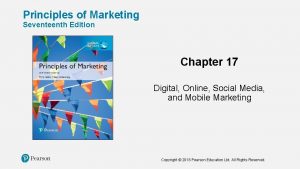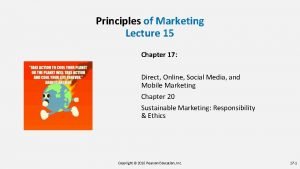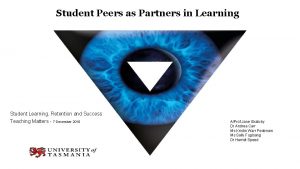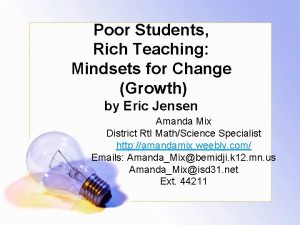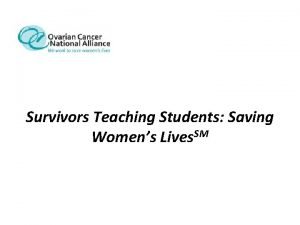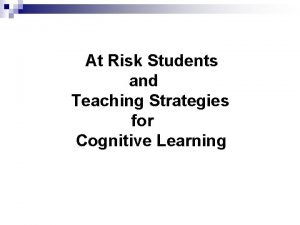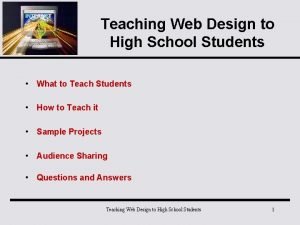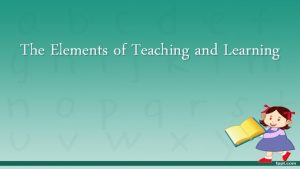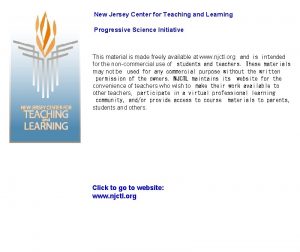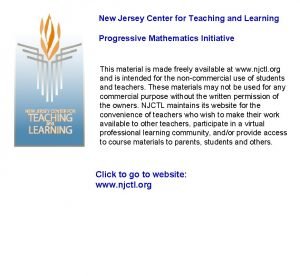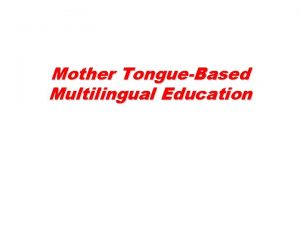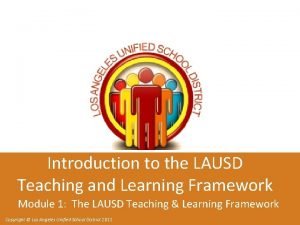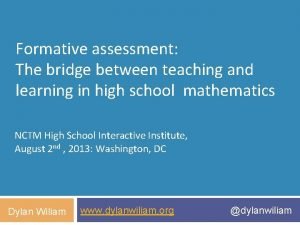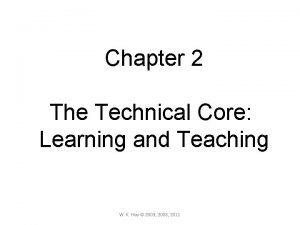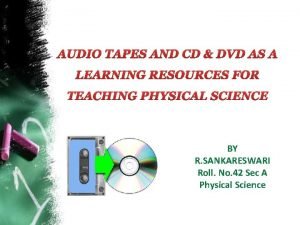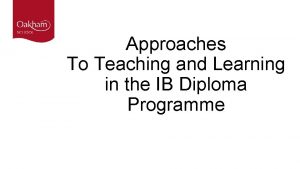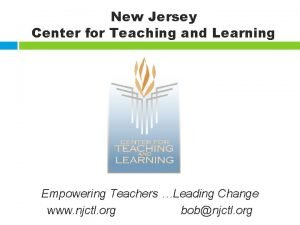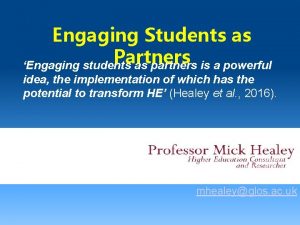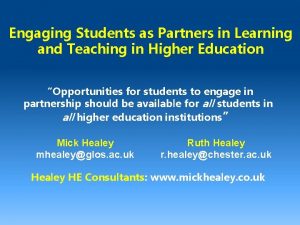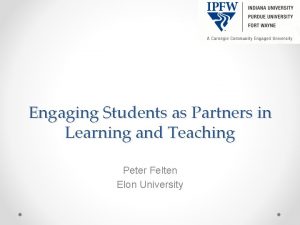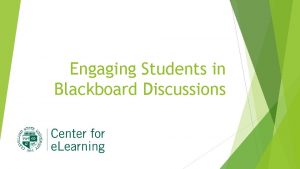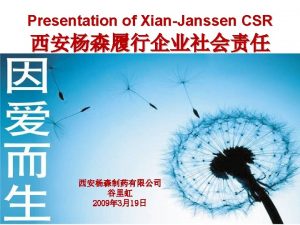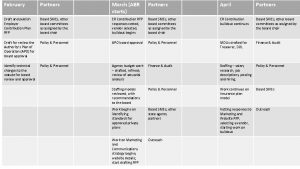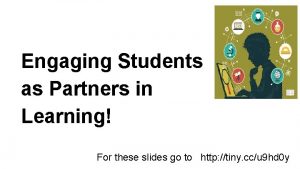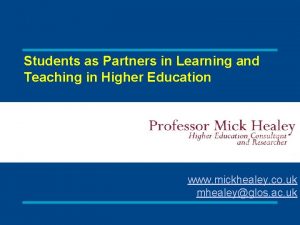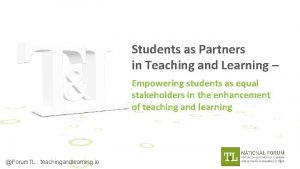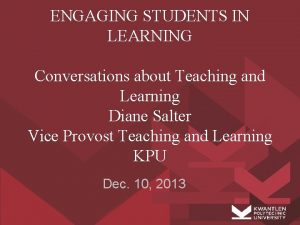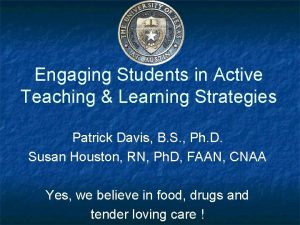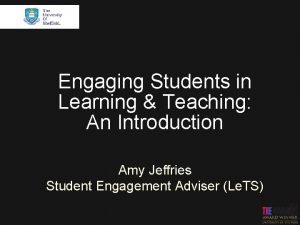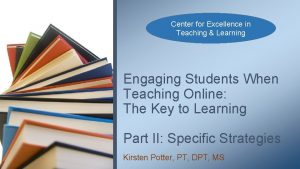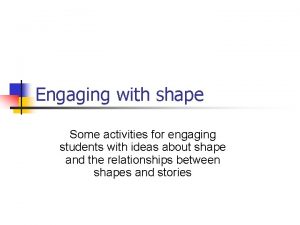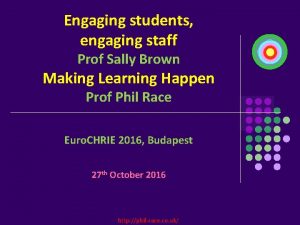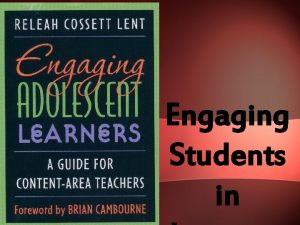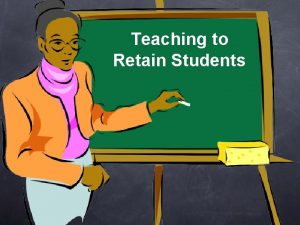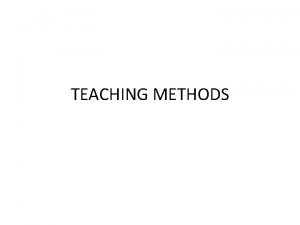Engaging Students as Partners in Learning and Teaching






















- Slides: 22

Engaging Students as Partners in Learning and Teaching in Higher Education “Opportunities for students to engage in partnership should be available for all students in all higher education institutions” Mick Healey mhealey@glos. ac. uk Ruth Healey r. healey@chester. ac. uk Healey HE Consultants: www. mickhealey. co. uk

Brief biographies Mick • HE Consultant and Researcher; Emeritus Professor University of Gloucestershire (Uo. G), UK; The Humboldt Distinguished Scholar in Research-Based Learning Mc. Master University, Canada; International Teaching Fellow, University College Cork, Ireland; • Principal Fellow HE Academy; SEDA@20 Legacy Award for Disciplinary Development; International Society for Scholarship of Teaching and Learning (ISSo. TL) Distinguished Service Award • Research interests: linking research and teaching; scholarship of teaching; active learning; developing an inclusive curriculum; students as change agents and as partners Ruth • Senior Lecturer in Geography, University of Chester • Senior Fellow HE Academy; • Editorial Board member Journal of Geography in Higher Education (since 2009) • Research interests: teaching for social transformation, teaching through debates in small groups, teaching ethics, ethical So. TL, and students as partners and change agents Both • National Teaching Fellows (2000 and 2017) • Inaugural co-editors of International Journal for Students as Partners • Directors of Healey HE Consultants

Students as partners: Structure Keynote 1. The nature of students as partners 2. Conceptual frameworks 3. Case studies: Students as partners 4. Principles of working in partnership 5. Action planning

Students as partners In pairs you each have ONE minute to tell the other of an example you are either familiar with or would like to see of: students as partners and as change agents in learning and teaching in HE

Students as partners in quality enhancement of learning and teaching “There is a subtle, but extremely important, difference between an institution that ‘listens’ to students and responds accordingly, and an institution that gives students the opportunity to explore areas that they believe to be significant, to recommend solutions and to bring about the required changes. The concept of ‘listening to the student voice’ – implicitly if not deliberately – supports the perspective of student as ‘consumer’, whereas ‘students as change agents’ explicitly supports a view of the student as ‘active collaborator’ and ‘co-producer’, with the potential for transformation. ” (Dunne in Dunne and Zandstra, 2011, 4).

Defining partnership “Partnership is essentially a process of engagement, not a product. It is a way of doing things, rather than an outcome in itself. ” Healey, Flint & Harrington (2014, 12)

Ladder of student participation in curriculum design Students in control Partnership - a negotiated curriculum Student control of some areas of choice Students control of prescribed areas Wide choice from prescribed choices Source: Bovill and Bulley (2011), adapted from Arnstein (1969) Limited choice from prescribed choices Participation claimed, tutor in control Dictated curriculum – no interaction Students control decision-making and have substantial influence Students have some choice and influence Tutors control decision-making informed by student feedback Tutors control decision-making Students increasingly active in participation

Students as partners in learning and teaching in higher education Source: Based on Healey, Flint and Harrington (2014, 25)

Implementing research-intensive education “At University College London, our top strategic priority for the next 20 years is to close the divide between teaching and research. We want to integrate research into every stage of an undergraduate degree, moving from research-led to research-based teaching. ” Michael Arthur, President and Provost, UCL, 30 April 2014: 22

UCL’s Connected Curriculum framework

Engaging students as partners in learning and teaching in HE In pairs each skim read a different case study (pp. 410). • • • Learning, teaching and assessment p. 4 Subject-based research and inquiry p. 5 Scholarship of teaching and learning (So. TL) p. 7 Curriculum design and pedagogic consultancy p. 8 Integrated approaches p. 9 Discuss whether any of the ideas may be amended for application in your context. 7 minutes

Engaging students as partners in learning and teaching ‘… students are neither disciplinary nor pedagogical experts. Rather, their experience and expertise typically is in being a student something that many faculty [staff] have not been for many years. They understand where they and their peers are coming from and, often, where they think they are going’ (Cook. Sather et al. 2014, 27).

Engaging students as partners in learning and teaching “Students possess tremendous experience and expertise in the areas of teaching and learning. Their experiences as learners … are far more grounded in reality than are those of most adults… They live teaching and learning every day. ” (Martin-Kniep, 2008).

Engagement through partnership Authenticity: the rationale for all parties to invest in partnership is meaningful and credible. Honesty: all parties are honest about what they can contribute to partnership and about where the boundaries of partnership lie. Inclusivity: there is equality of opportunity and any barriers (structural or cultural) that prevent engagement are challenged. Reciprocity: all parties have an interest in, and stand to benefit from working and/or learning in partnership. Empowerment: power is distributed appropriately and ways of working and learning promote healthy power dynamics. Trust: all parties take time to get to know one-another and can be confident they will be treated with respect and fairness. Courage: all parties are encouraged to critique and challenge practices, structures and approaches that undermine partnership, and are enabled to take risks to develop new ways of working and learning. Plurality: all parties recognise and value the unique talents, perspectives and experiences that individuals contribute to partnership. Responsibility: all parties share collective responsibility for the aims of the partnership, and individual responsibility for the contribution they make. Source: HEA (2015)

Students as partners In pairs think of an example you are familiar with or one of the case studies you looked at earlier of students as partners in learning and teaching in HE and discuss how far the principles we identified apply. 4 mins

Cited over 200 x in 3 years

Students as partners and change agents In threes and fours one of you should identify a way in which you propose to engage the students in your programme or institution as partners and the others should act as critical friends. 5 mins

International Journal for Students as Partners (IJSa. P) • Research articles, case studies, opinion pieces, reflective essays and reviews • International editorial team of students and staff from Australia, Canada, UK and US IJSa. P explores new perspectives, practices, and policies regarding how students and staff are working in partnership to enhance learning and teaching in higher education https: //mulpress. mcmaster. ca/ijsap

3 rd Mc. Master International Sa. P Institute: 11 -14 June 2018 Where possible pairs of staff and students are invited to participate in either one or two consecutive two-day workshops Alternatively teams of 4 -6 faculty and students (at least two of each) from an institution(s) can apply to join a 3. 5 day ‘Change Institute’ Facilitated by an international team of experienced staff and students from Australia, Canada, UK and US https: //macblog. mcmaster. ca/summer-institute/

Students as partners: A vision “ … it should be the norm, not the exception, that students are engaged as co-partners and co-designers in all university and department learning and teaching initiatives, strategies and practices. ” (Healey, 2012)

Students as partners: Conclusions If students as partners and change agents are to be truly integrated into HE then the nature of higher education will need to be reconceptualised. “universities need to move towards creating inclusive scholarly knowledge-building communities. … The notion of inclusive scholarly knowledge-building communities invites us to consider new ideas about who the scholars are in universities and how they might work in partnership. ” (Brew, 2007, 4) There is a need to do more thinking ‘outside the box’

Engaging Students as Partners in Learning and Teaching in Higher Education An invitation to participate and send us a case study THE END
 Types of brow presentation
Types of brow presentation Dynamisch verbinden
Dynamisch verbinden Marketing involve engaging directly with carefully targeted
Marketing involve engaging directly with carefully targeted Marketing involve engaging directly with carefully targeted
Marketing involve engaging directly with carefully targeted What made rizal as champion of filipino students
What made rizal as champion of filipino students Peers as partners in learning
Peers as partners in learning Adoption learning partners hague training
Adoption learning partners hague training Microteaching meaning
Microteaching meaning Cuadro comparativo e-learning m-learning b-learning
Cuadro comparativo e-learning m-learning b-learning Relational mindset
Relational mindset Survivors teaching students
Survivors teaching students Teaching at risk students
Teaching at risk students Teaching web design to high school students
Teaching web design to high school students Fundamental equipment of the learner
Fundamental equipment of the learner New jersey center for teaching and learning
New jersey center for teaching and learning New jersey center for teaching and learning
New jersey center for teaching and learning Guiding principles for teaching and learning in mtb-mle
Guiding principles for teaching and learning in mtb-mle Lausd teacher framework
Lausd teacher framework Assessment the bridge between teaching and learning
Assessment the bridge between teaching and learning Technical core
Technical core Examples of audio visual materials in teaching
Examples of audio visual materials in teaching Ib approaches to teaching
Ib approaches to teaching Www.njctl.org answer key
Www.njctl.org answer key
